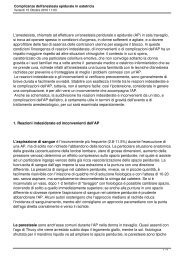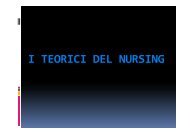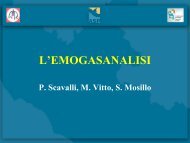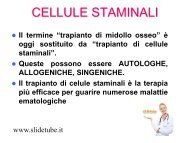Download - Slidetube.it
Download - Slidetube.it
Download - Slidetube.it
You also want an ePaper? Increase the reach of your titles
YUMPU automatically turns print PDFs into web optimized ePapers that Google loves.
Percorsi Assistenziali Neonatologici Anno 2008<br />
*<br />
I livelli bilirubinemici sopra riportati sono da considerarsi utili per programmare<br />
il primo intervento di exsanguinotrasfusione. Per gli interventi successivi al<br />
primo, ove necessari, si può essere meno interventisti considerando oltre che il<br />
livello di bilirubinemia anche altri fattori condizionanti quali:<br />
a. livello di bilirubinemia pre-exsanguinotrasfusione<br />
b. rebound bilirubinemico post-exsanguinotrasfusione<br />
c. presenza di emolisi<br />
d. tollerabil<strong>it</strong>à dell'intervento<br />
e. stato generale del neonato al momento della decisione.<br />
1. Sm<strong>it</strong>herman H, Stark AR, Bhutani VK. Early recogn<strong>it</strong>ion of neonatal hyperbilirubinemia and <strong>it</strong>s emergent management. Semin<br />
Fetal Neonatal Med 2006; 11:214-224.<br />
2. Romagnoli C, De Luca D, Zuppa AA, Parenti D, Latella C. Could early serum bilirubin measurement be useful in predicting<br />
non physiologic hyperbilirubinemia? Ital J Pediatr 2005;31:52-60.<br />
3. American Academy of Pediatrics. Subcomm<strong>it</strong>tee on Hyperbilirubinemia. Management of hyperbilirubinemia in the newborn<br />
infant 35 or more weeks of gestation. Pediatrics 2004; 114:297-316.<br />
4. Murray NA, Roberts IA, Haemolytic disease of the newborn. Arch Dis Child Fetal Neonatal Ed 2007;92;83-88<br />
5. Maisels MJ, Watchko JF. Treatment of jaundice in low birthweight infants. Arch Dis Child Fetal Neonatal Ed 2003; 88:F459–<br />
F463<br />
6. Which phototherapy system is most effective in lowering serum bilirubin in very preterm infants? Romagnoli C, Zecca E,<br />
Papacci P, Vento G, Girlando P, Latella C. Fetal Diagn Ther 2006;21:204-209.<br />
7. Ip S, Chung M, Kulig J, O’Brien R, Sege R, Glicken S, Maisels J, Lau J, and the Subcomm<strong>it</strong>tee on Hyperbilirubinemia. An<br />
Evidence-Based Review of Important Issues Concerning Neonatal Hyperbilirubinemia. Pediatrics 2004;114: e130–e153. URL:<br />
http://www.pediatrics.org/cgi/content/full/114/1/e130.<br />
8. Chou SC, Palmer H, Ezhuthachan S, Newman C, Pradell-boyd B, Maisels MJ, Testa MA. Management of hyperbilirubinemia in<br />
newborns: measuring performance by using a benchmarking model. Pediatrics 2003;112:1264-1273.<br />
9. Wenneberg RP, Ahlfors CE, Bhutani VK, Johnson LH, Shapiro SM. Toward understanding kernicterus: a challenge to improbe<br />
the management of jaundiced newborns. Pediatrics 2006;117:474-485.<br />
10. Newman TB, Liljestrand P, Jeremy RJ, Ferreiro DM, Wu YW, Hydes ES, Escobar GJ, for the jaundice and infant feeding study<br />
team. Outcomes among newborns w<strong>it</strong>h total serum bilirubin levels of 25 mg per decil<strong>it</strong>re or more. N Engl J Med<br />
2006;354:1889-1900.<br />
11. Jackson JG. Adverse Events Associated W<strong>it</strong>h Exchange Transfusion in Healthy and Ill Newborns. Pediatrics1997;99(5).<br />
http://www.pediatrics.org/cgi/content/full/99/5/e7;<br />
229<br />
Metabolici

















